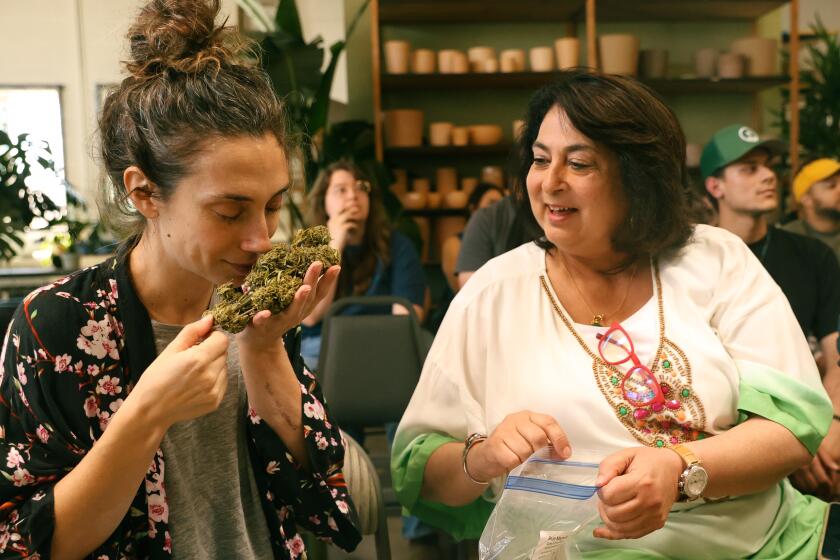Acagchemem Tribe Nourishes Ancient Roots in County
Jeanie Marine and her relatives sat near the weeping willow in her front yard to escape the still-strong heat of the late afternoon. As Marine’s grandchildren, Laughing Bear and Little Flower, roamed about the yard, the talk among the adults was about their ancestors, the first inhabitants of Orange County.
The family members are Acagchemem Indians, the only American Indian tribe indigenous to Orange County. Once thought extinct, about 2,000 Acagchemem (pronounced a-HAH-shay-mem) still live in the county, just as they have for thousands of years.
Traces of the Acagchemem way of life are evident throughout the Marine household. An herb garden, which Marine cultivates for traditional medicine, thrives in the back yard. Pictures of ceremonies and traditional artifacts occupy a part of the living room.
“Basically, we are still on our land,” said Marine’s sister, Sonia “White Feather” Johnston, who lives in Huntington Beach. “I for one don’t plan to leave it. It’s home. . . . The land is part of our culture. I don’t feel that we can have our culture without the land.”
Orange County is home to about 13,000 American Indians from about 100 tribes, a small population compared to the almost 50,000 in Los Angeles County.
“There’s a good mix of Indian languages here,” said John Castillo, director of the Southern California Indian Center in Garden Grove. “Our unifying thread is the belief that the earth is a living spirit. (We believe) in living in harmony with creation, in the respect for elders, in (having) an inner balance with yourself.”
After decades in which Indians were encouraged to conceal their heritage, many now are trying to learn more about their roots. Many youths are learning the traditional ceremonies and dances; some try to rediscover the lost languages. “There’s been a renaissance, a renewal of Indian people recognizing their heritage,” said Castillo, who is part Apache.
Even with the resurgence, the Acagchemem pretty much keep a low profile, a reticence that is consistent with their spirituality.
“They are very quiet,” said Lupe Lopez, a member of the San Juan Capistrano Indian Council. “The only time you see them in full force, in full regalia, is at the powwows.”
The tribe is trying to be officially recognized by the federal government.
The acknowledgment from the government, which takes years to finalize, would allow the Acagchemem to have a reservation of sorts on their ancestral land, said tribal chairman Dan Belardes. The tribe hopes to find some land, perhaps close to the mission in San Juan Capistrano, where it can build a museum and a facility for ceremonies, Belardes said.
It would also free up some federal money to help with education and job training, and money to teach tribal people about their own culture, Belardes said.
Tribal leaders are also busy protecting their heritage throughout Orange County as development constantly encroaches on their ancestral burial grounds.
“Our ancestors are buried here,” said Johnston’s husband, Darrell. “We have a responsibility to watch over them. We have a certain responsibility that we inherited.”
It is a long inheritance. The Acagchemem were well-established in Orange County years before Gaspar de Portola and his explorers first set up camp near present-day San Juan Capistrano in July, 1769, according to Merle and Mabel Ramsey in their book, “This Was . . . Mission Country. The Reflections in Orange.”
The Spaniards called the natives they found in the county “Juanenos,” after the mission they built at San Juan Capistrano.
The Acagchemem led a simple life.
People of the Acagchemem nation used to roam the fertile valley bordered by the Santa Margarita and San Gabriel rivers, the Santa Ana Mountains and the Pacific Ocean.
They were the initiators of the Chinigchinich religion.
“We believe in the Great Grandfather, the great Na-natachee,” Marine said. “He’s the Great Creator. You honor everything because the Great Creator created everything so we could survive.”
The Acagchemem’s deistic society stressed respect for authorities. They lived off the abundance of the land. They hunted for rabbits, squirrels, deer and other game. They also fished the ocean. They didn’t plant or cultivate crops, but rather relied on wild seeds and acorns.
They were the original environmentalists.
“We have respect for the animals, the ground that we walk on, the wind, the plants,” Marine said. “My grandmother used to tell me if you don’t hurt a tree, that tree will be good to you. That tree will give you fruits.”
They were the first Indians in California to be converted to Christianity.
“The Orange County Indians’ deism and ingrained respect for authority assisted the missionaries in convincing the Indians to adopt a new way of life, one that would for a time totally stamp out their traditions and culture,” wrote Pamela Hallan-Gibson in “The Golden Promise--An Illustrated History of Orange County.”
Today’s Acagchemem, like Marine’s clan, still practice ceremonies and traditions handed to them from their predecessors.
The family is the center of the Acagchemem life, Marine said. Hers totals about 200 members, from infants to cousins to grandparents who gather monthly, passing traditions and customs down through the generations. Sometimes, they meet to perform ceremonies. In keeping with the Acagchemem ways, the family is reluctant to talk about their traditions and ceremonies.
“Most of our rituals are sacred rituals,” tribal chairman Belardes said. “Most of the songs and dances are done in the sacred arbor at night.” Some of the ceremonies are performed on the beaches and sacred sites, but family members are reluctant to be specific.
Sonia Johnston added: “Our culture is not for the public to know about. . . . It’s for our family. We are a real spiritual people. . . . You read a lot about the Hopi, you read a lot about the Pueblo Indians . . . but that’s not the way we have been brought up to do.”
There is an effort to revive the Acagchemem language, which has been preserved though songs, prayers and oral history. Some of the elders still speak it. The Marine family say they speak it in ceremonies.
Last year, Acagchemem was spoken for the first time in the 216-year history of the Mission San Juan Capistrano during the traditional St. Joseph’s Day Mass.
Marine learned the history and tradition of her people through her great-grandmother’s stories. Recalling those lessons, Marine said:
“She always told me: ‘Don’t ever forget you are an Indian.’ ”
More to Read
Start your day right
Sign up for Essential California for news, features and recommendations from the L.A. Times and beyond in your inbox six days a week.
You may occasionally receive promotional content from the Los Angeles Times.






